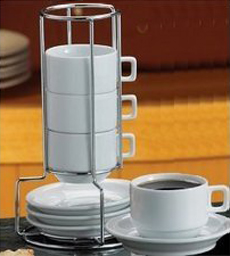FOOD 101: The Difference Between Coffee & Espresso
|
|
The flavors of espresso are very concentrated, intense and dark. Espresso is drunk black; sugar is permissible but milk is not. If you want milk in your coffee, choose another dark roast bean: Italian Roast and French roast.
There are key differences between espresso, Italian Roast and French roast coffees. 1. Beans: Special. Espresso is not a type of bean, but a level of roasting. In fact, espresso is typically a blend of beans roasted anywhere from very light to very dark; you know it’s espresso if there’s a lot of surface oil evident. Different coffee roasters use different blends of beans and different degrees of roasting. Ask which roaster roasted the beans you are purchasing. If they’re not your ideal, keep trying different roasters. 2. Caffeine: Less. Because a cup of espresso takes no more than 30 seconds to brew (28 seconds is the ideal brewing time), less caffeine is extracted from the ground beans than in drip coffee, which takes anywhere from 5 to 7 minutes to brew. |
|
|
3. Crema: Thick. The pressure exerted by the espresso machine forms a thick cap of brown crema (pronounced CRAY-mah, Italian for cream; but it’s “espresso bean cream,” not milk-related cream). Some single serve coffee machines also produce a crema; but true espresso crema carries the aroma and lasts to the bottom of the cup. 4. Portion: Small. Although modern designs veer from the classic style, espresso cups were intentionally made small and thick. They serve a different purpose from the delicate porcelain demitasse cups used for regular coffee in a fine dinner service. Thick, small espresso cups hold the heat; large cups dissipate the heat and the crema. The proper portion of espresso is one ounce for these reasons. If you want a larger serving of espresso, don’t fill a full-size cup: Have another espresso-size and drink it in its peak form. 5. Garnish: Lemon Peel. You may see espresso served with a piece of lemon peel, to be rubbed around the rim of the cup to leave a slick of lemon oil. The original purpose was to counteract the taste of over-roasted, overly bitter espresso: The oil in the peel blocks the bitterness. Italians traditionally serve top quality espresso without lemon peel, bowing to the quality of the beans. However, if you like the added flavor of the lemon peel (we do), feel free to serve it. 6. Freshness: Imperative. Advice continues to circulate that coffee beans should be kept in the freezer for freshness. False! Freezing the coffee coagulates the natural oils contained in the bean. In an espresso, those oils need to emulsify to produce the body and mouthful of the coffee. Coffee can be stored in the refrigerator, but airtight containers are crucial. An airtight container keeps out odors and protects the internal moisture of the coffee bean. No matter what kind of coffee you buy, the best rule of thumb is to buy only what you need for a week, or two weeks at best. Ground coffee will begin to go stale in 24 hours. Keep coffee away from direct light and heat. Direct light and heat begin to cook the coffee oils, and will affect the flavor and aroma properties. Discover more about coffee in our Gourmet Coffee Section.
|
||



